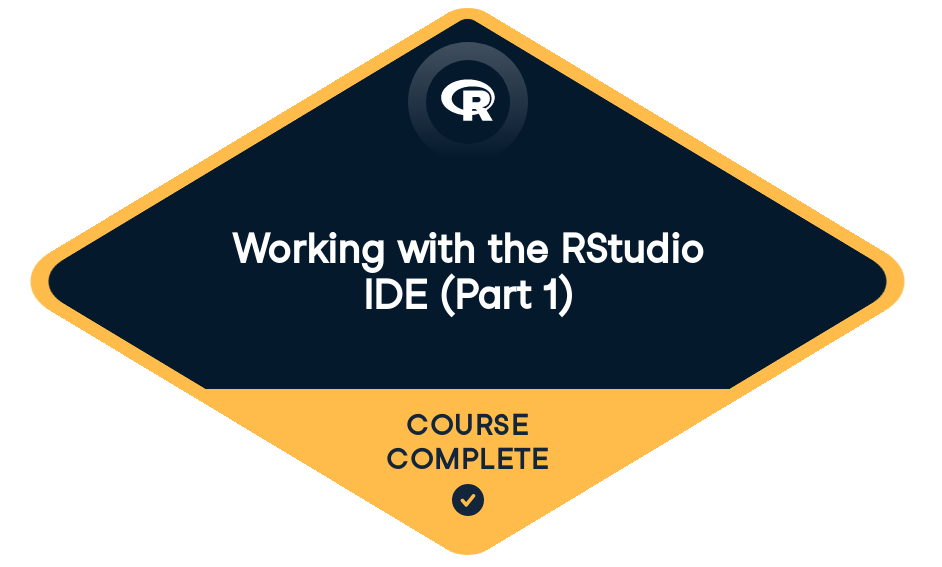
Loved by learners at thousands of companies
Course Description
In the first part of this two-part RStudio tutorial, you will learn how to use RStudio, an IDE for R.
Chapter 1 will cover:
- how to install R Studio for Mac, Windows, or Linux
- how to run R code
- debugging in R
Chapter 2 will get into the features of the IDE geared toward making you a more effective R programmer, including code diagnostics and running scripts.
Finally, Part 1 finishes with a brief chapter on using RStudio projects for organizing and sharing your code with others.
In Part 2, you will learn how RStudio makes it easy to build your own R packages, integrate with GitHub, and use tools like R Markdown.
Training 2 or more people?
Get your team access to the full DataCamp platform, including all the features.- 1
Orientation
FreeThis chapter shows you around the most important parts of the RStudio IDE. You'll learn about the data viewer, the environment tab, the history tab, how to set and get your working directory, using the plots pane, navigating the help tab when you get stuck, and more.
Introduction50 xpWhat is an IDE anyway?50 xpInstall R and RStudio50 xpLet's get you set up!50 xpRStudio's panes50 xpHelpful commands for new users50 xpHow to clean up your console50 xpUsing the tab button50 xpThe source pane50 xpRStudio IDE file types50 xpExecuting code50 xpThe View() function50 xpUsing the View() function (1)50 xpUsing the View() function (2)50 xpThe environment pane50 xpUsing the environment pane50 xpLooking at the environment pane50 xpThe history pane50 xpLooking at the history tab50 xpThe files pane50 xpGetting used to the files pane50 xpSetting a working directory (1)50 xpSetting a working directory (2)50 xpThe plots pane and the packages tab50 xpLet's look at the plots pane50 xpLet's look at the packages tab50 xpThe help pane50 xpWorking with the help pane50 xpThe viewer pane50 xpLet's use the viewer pane!50 xpPublishing content from the viewer pane50 xpWrap-up50 xpLet's get some practice! (1)50 xpLet's get some practice! (2)50 xpLet's get some practice! (3)50 xp - 2
Programming
This chapter builds on the last by showing you how to take advantage of the IDE for a more efficient and enjoyable R programming experience. For example, you'll see how RStudio's built-in code and style diagnostics can flag things before they go terribly wrong. You'll learn tricks for using multiple cursors at once, collapsing code for better visibility, and using RStudio's handy tools for debugging your code.
RStudio's coding features50 xpCode completion features50 xpCode diagnostics50 xpDiagnostic features50 xpFixing code in the text editor using diagnostic features50 xpKeyboard shortcuts50 xpGenerating the pipe operator using keyboard shortcuts50 xpTrying new shortcuts50 xpDiscovering new shortcuts50 xpMultiple cursors50 xpHow do we use multiple cursors?50 xpNavigate & edit code50 xpFinding the right line of code50 xpClosing folds50 xpRun scripts50 xpSourcing an entire file50 xpRefreshing your R session50 xpTraceback50 xpFinding an error50 xpDebugger mode50 xpGetting comfortable with debugger mode50 xpExiting debugger mode50 xpDebugger mode: breakpoints50 xpProgrammatically opening debugger mode (1)50 xpProgrammatically entering debugger mode (2)50 xp - 3
Projects
In this brief chapter, you'll see how to use RStudio projects to organize and share your code with others. Projects come with many benefits, including the ability to keep all relevant files in one place and to easily search all of these files with a single command. You'll also be exposed to the Packrat system for package management and reproducibility.
Training 2 or more people?
Get your team access to the full DataCamp platform, including all the features.collaborators

prerequisites
Introduction to RJoin over 18 million learners and start Working with the RStudio IDE (Part 1) today!
Create Your Free Account
or
By continuing, you accept our Terms of Use, our Privacy Policy and that your data is stored in the USA.